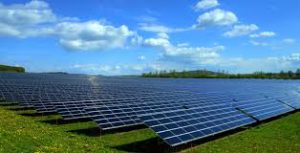The sun irradiates light in a periodical daily and yearly cycle onto the earth. The energy made available for us depends on the distance to the sun and fluctuates between 1230 and 1240 W per m². The average value is 1370 W per m² and is known as solar constant.

Solar energy
While penetrating the atmosphere sunlight is gradually becoming less intense. It is reflected or scattered as well as absorbed by the atmosphere, such as UV-light is being absorbed by ozone. Molecules that are smaller than the wavelength of the incoming light scatter it (Rayleigh scattering). That is the reason why we have a blue sky.
Furthermore small particles, such as dust and aerosols also induce scattering processes. The lower the position of the sun is, the longer the way of the light through the atmosphere and the higher the attenuation. This effect is called Air Mass (AM). At AM=1 the sun is at the zenith (90°), while at AM=3 roughly 20° above the horizon. The radiation that finally reaches the ground is called global radiation and is composed of direct and scattered indirect radiation.
During a cloud-free summerday at noon in Germany, sunlight reaches a power of roughly 1 kW per m². That means in one hour it radiates energy of 1kWh onto one m². In order to achieve a high power, it is important that light reaches the electricity generating device in a direct way.
A cloudy sky induces scattering of the light and therefore reduces the power from the sun to 10 up to several 100 W/m². During one year, the energy input (solar radiation) for Germany is roughly 1000 kWh/m². Each square meter thus receives 1000 kWh of energy which can be transformed into electricity or heat.
In Germany, the most common way to generate electricity from solar radiation is photovoltaic (PV). The last years saw quite a boom of installations with currently more than 40 GW of installed capacity. Especially in the south of Germany there are many small-scale PV power plants on roof areas.
PV modules must not be confused with vacuum-tube or flat-plate collectors, which are used for heating water.



